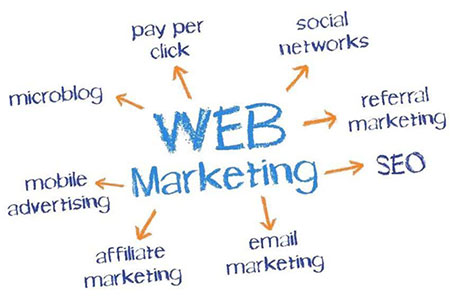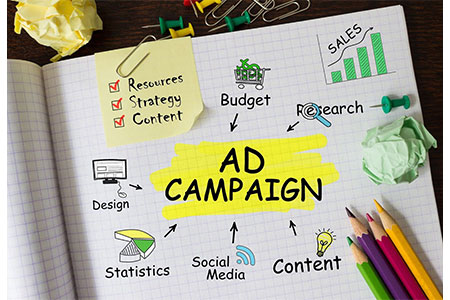Web Advertising
What is Web Advertising?
The usage of web in web advertising simply means using the Internet to deliver promotional messages to customers. It offers the most flexible options in terms of selection of targets and measurements in real time compared to traditional media. It ranges from putting a banner ad on a website to online ads within social networks, allowing advertisers to connect with individuals while they are online and spending their time. Web advertisers have both online measurement and optimization tools to analyze their impact and further strengthen their campaigns, thereby moving towards greater effectiveness. And as digital behavior adapts, web advertising also evolves, fusing raw data with creativity to generate user experiences that are relevant. Visibility in the crowded online world is not synonymous with being simply seen but with reaching the right people with the right message at the right moment. There lies the promise of web advertising.

What are the Various Forms of Web Advertising?
Display Ads
Display advertising is the most prevalent type of online advertisement, which one would generally see in the shape of banners, pop-ups, or sidebars on a website. These catchy shapes are created to capture people's attention and induce awareness or clicks under time pressure. Display advertising incorporates bold images, animation, and brief copy to advertise products or services. Static or dynamic, ads can be positioned in strategic positions on subject sites to reach the desired individuals. Finer targeting enables marketers to personalize advertisements based on interest, age, or web behavior. Display advertisements, when perfectly executed, become direct visual prompts nudging the buyer through the purchase process.
Search Engine Marketing (SEM)
Search Engine Marketing, or SEM, is a pay-for-performance web ad format that drives sites via paid listings in search engines. They are shown when users search for the relevant keywords, providing immediate visibility at the top of the search. SEM campaigns can be highly tailored, and companies can target by time of day, place, language, and device. With exact keyword targeting and quantifiable performance, SEM accomplishes reach and relevance. The model is also cost-effective in that advertisers pay only when users click. Whatever the purpose is, whether advertising a new product or pushing sales, SEM positions your company in the face of potential buyers at the very moment they are looking for it.
Social Media Ads
Social media marketing takes advantage of the massive user base of social media platforms like Facebook, Instagram, LinkedIn, and TikTok to provide targeted advertising messages. The advertisements are naturally integrated into people's timelines and stories as native content that evokes engagement without intrusiveness. With high-interest targeting, behavior targeting, and demographic targeting, one can accurately reach the targeted audiences. Social media ad grows, live, and die on visuals, story, and interactivity, making brand awareness, lead generation, or direct conversion perfect for it. From in-stream video, carousel, to sponsored post, well-targeted social media ads are capable of turning passive scroll into conversion, establishing trust, and creating conversation, resulting in lifetime customers.
Native Advertising
Native advertising naturally blends promotional content into the immediate digital landscape, thus not feeling artificial or intrusive. As sponsored posts, in-feed social media, or recommendation widgets, native advertising matches the format and tone of the site they're on. Native web ad operates to build trust as value-based content that generates value for users instead of hard selling. Native advertising produces higher engagement and a better user experience, as it doesn't disrupt browsing. Owing to the marriage of relevance and stealthiness, native advertising enables brands to talk to individuals naturally, to provide useful information while nudging users toward conversion in a surreptitious way.
Email Marketing
Email marketing remains a mainstay of internet advertising, with one-to-one interaction with a very targeted audience. With permission-based newsletters, promotions, or product releases, organizations have the ability to develop lead and customer relations. Email marketing allows segmentation by user behavior, purchase, or degree of interaction so that content appears in the right people's inboxes. Automation software streamlines scheduling, testing, and optimizing campaigns, driving open rates and conversions. Inexpensive and trackable, email marketing is a safe touchpoint throughout the customer lifecycle. Done properly, it's not just an ad, it's a relationship builder that remembers your brand.

Why is Web Advertising Important?
Precise Audience Targeting
Among the strongest advantages of web advertising is that it can provide targeted audiences. Offline promotions toss their message out to the wind, hoping it will come back in a breeze. Online promotions, however, go straight for the prospects by tapping into user data such as interests, behaviors, and demographics. This kind of targeting limits multidirectional waste and builds up ROI. Whether you're promoting to fresh leads or remarketing old visitors, web advertisement software enables you to segment down to the very finest details. Extremely tailored messages enhance the user experience, with the user feeling the interaction is more suitable and tailored. Ultimately, directed web advertisement ensures your message lands on its target every single time.
Global or Local Reach
Internet marketing is not limited geographically, which creates room for businesses to access audiences internationally or in a local neighborhood. Whether your neighborhood bakery wants to attract people passing by or an international SaaS organization looking for international subscribers, online campaigns can be customized accordingly. Advertisers can split by country, city, and zip code with the click of a mouse. This flexibility makes it possible for businesses of any size to target markets of their choice. Web advertising's global-local presence puts your brand anywhere your perfect customer is—online. It's not a question of casting a broad net, but of casting it wisely.
Real-Time Impact Tracking
Web advertising makes it possible to measure campaign success in real time—something traditional advertising can't even begin to do. From impressions and clicks to conversion and bounce rate, every moment of engagement can be followed. Advertisers can track campaigns via dashboards and experiment at the flip of a switch to get the best performance. Transparency favors better decision-making, with advertising spend constantly optimized. Whether it is A/B-testing of a headline or fine-tuning audience segments, real-time data means adaptability. It also allows for accountability, clients and stakeholders can immediately see ROI. With web advertising, you're never flying blind; every campaign has a narrative founded on data that makes scaling what works and correcting what doesn't simple.
Full Budget Control
You have constant control over your money with web advertising. Whether a small company with modest budgets or a major company with big campaigns, web-based channels allow you to allocate daily, monthly, or lifetime budgets. You can halt, accelerate, or reallocate budgets in real-time based on performance signals. Compared to cost-committed offline advertising, web ad spend is performance committed and nimble. You only buy real engagement, clicks, impressions, or conversions, guaranteeing effectiveness. This budget flexibility enables small businesses to compete strategically even when budgets are low. Control in web advertising isn't simply a question of cost, it's getting maximum value out of every dollar spent.
Continuous Visibility & Engagement
Web advertising differs from conventional media in that it is not time-bound and offers 24/7 visibility and interaction. As campaigns stand active, the audience browses, shops, and engages anytime, day or night. Continuous visibility keeps the brand top-of-mind and prompts interaction. Retargeting, in combination with automation, helps to lead potential buyers through a sales funnel over periods of time. Whether it is a reminder about a wonder product or an exclusive discount, repeated exposure breeds trust and a positive feeling. Web advertising avoids your brand merely making a fleeting impression, it makes lasting relevance. It is not only visibility when done correctly; it is a two-way dialogue with your audience.

Real World Examples of Web Advertising
Different highly influential campaigns have shown the real strength of web marketing. An example is the social media marketing of Airbnb, which leveraged user-generated content to promote offbeat accommodations and created international interest. Nike pre-roll YouTube campaigns employed storytelling with data-driven targeting to provoke action, particularly among the young generation. Spotify display and email ads, driven by listening data, provided hyper-personalized experiences that improved user retention. The second is the case of Amazon's SEM strategy taking over product searches by showing up precisely when shoppers are prepared to purchase. These ads didn't merely blast out messages, far from it, in fact, and instead interacted on an emotional level, provided value, and leveraged platforms. Real web advertising success is all about strategy, relevance, and timing.

Conclusion
It's a Web advertisement; it's no longer an option- it is the online marketing set to any kind of campaign. From search engines to social news feeds, the most potent barriers to targeting are the paradox of responsiveness and measurability of the product. The brand is free to engage with the right people at the very moment with the right message from anywhere locally to anywhere on the globe. Be it interactive display advertising, subliminally addressed email, or smartly placed search advertising, Internet ads create awareness, engagement, and the conversion process. Its strength is responsiveness and precision, enabling marketers to refine every campaign in real-time. Because consumers' behaviors constantly change on the internet, web advertising will be the most effective means of remaining seen and current. Investing in it now guarantees long-term online growth and competitiveness.
FAQs
Web marketing provides more targeted targeting, in-time monitoring, interactive content, worldwide outreach, and cost-effectiveness over the general, static nature of conventional advertising.
Retargeting is done by identifying individuals who have been on your website, then targeting them with internet ads elsewhere on the web, so that they will come back to your website and take whatever action was taken on the original visit to your website.
Cookies enable online adverts to monitor users, enabling advertisers to deliver targeted adverts. But with privacy laws like GDPR that necessitate privacy policies, advertisers are required to offer transparency about the use of data and consumer consent before they can utilize data.
Level of success is measured based upon metrics such as CTR, CPC, CPM, conversion rates, ROAS, etc. that offer the ability to optimize performance results and advertising plan.
Fake clicks or impressions via bots are a type of ad fraud that wastes ad spend. There are many tools that help prevent and monitor fake clicks and impressions for protection.
Keep messaging easy to read, images and/or video grab attention, mobile-centric, and with prominent CTAs. Experimenting with different messaging formats and targeting will also work in optimizing ad performance in the future.
Mobile advertising is designed for smaller screens and tap-based usage, while desktop advertising supports more extensive images and longer content engagement styles.
Ad blockers reduce visibility, and privacy laws such as GDPR limit tracking. Advertisers must place consent-based, user-empathetic ad models center stage in order to stay compliant.
Landing pages are special-purpose pages for specific ads, which assist in enhancing message relevance, minimizing bounce rates, and maximizing conversion rates.
Organic advertising takes its visibility by depending on SEO, while paid web advertising utilizes targeted advertisement to show up instantly in front of chosen audiences.



